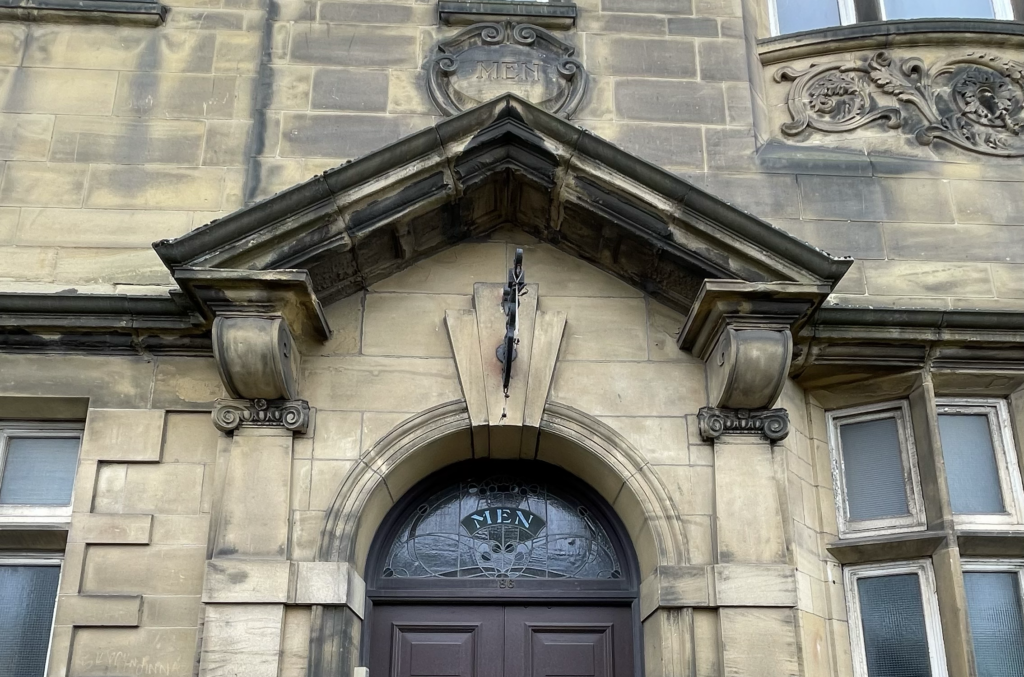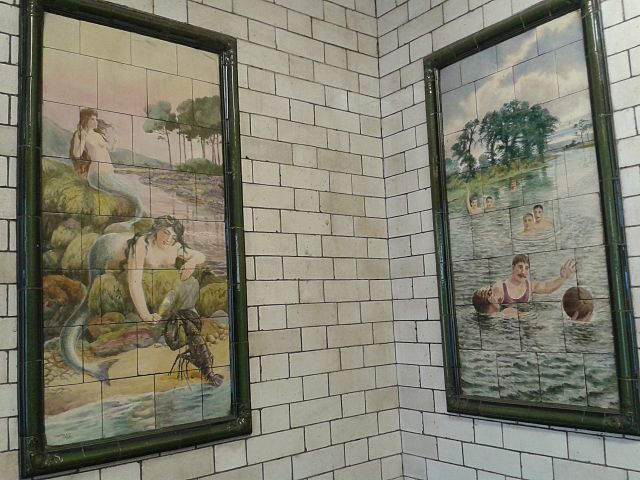
Facade of Gibson Street Baths, Newcastle-upon-Tyne. Photograph: Graham Tyrrell
Gibson Street Baths, Newcastle-upon-Tyne. Grade II, F. H. Holford, 1906 –1907
Included on the Society’s 2025 list of Top Ten Endangered Buildings is this proud but crumbling Edwardian building.
Griff Rhys Jones OBE, Victorian Society President, said: ‘I have lost count of the number of public bath houses that we see in decline, but people truly love these local amenities. There are passionate groups standing by to save their water pools and services, but here bureaucracy has wound them in a skein of “strings attached”. Please let the local supporters get to work and raise the funds and find a good new integrated use for what was once a prime example of public concern and welfare and an illustration of Victorian-Edwardian values at their best.’
The rapid, unplanned growth of towns and cities during the Industrial Revolution left little provision for public hygiene. With disease widespread, the 1846 Public Baths and Wash-houses Act – prompted by a campaign led by the Bishop of London – became the first legislation empowering local authorities to build public bathing facilities, funded via the Poor Rate. In Newcastle, an 1845 report highlighted the issue: with river access curtailed by development along the Tyne, working-class people were left without suitable or private places to bathe. Existing baths in the city’s upper parts were inaccessible to the poor. Recommendations included creating affordable or free public baths near steam engines to provide hot water in winter.
Gibson Street Baths, opened in 1907, was the fourth such facility built in Newcastle under the Act and is now one of just three pre-1914 swimming baths still standing in Tyne-and-Wear (alongside Byker and Wallsend). Constructed at a cost of £28,000, Alderman Holmes described it as “the most complete set of baths for their size in England.” The opening ceremony was marked by a performance from Olympic swimmer Arthur ‘Jack’ Jarvis, and the baths provided both slipper baths and laundry facilities.

The men’s entrance to Gibson Street Baths. Photograph: Graham Tyrrell.
Men and women entered through separate doors, and the interior boasts exquisite tiling. The men’s entrance hall features four remarkable panels: two signed by the celebrated Dorset tile-makers Carter & Co, depicting mermaids, and two others showing a water polo match and a diver in striped swimwear – extraordinary works praised by architectural historian Lynn Pearson as without parallel, even in Britain’s grandest historic baths. A fifth panel lists the 15 members of the Baths & Wash Houses Committee, as well as the architect and builders, beneath Newcastle’s coat of arms.

Interiors tiles in reception at Gibson Street Baths in Newcastle. Photograph: Empty Images – Creative Commons Attribution-Share Alike 4.0 International License

Interiors tiles in reception at Gibson Street Baths in Newcastle. Photograph: Empty Images – Creative Commons Attribution-Share Alike 4.0 International License
During WWII, the baths’ reservoir served the National Fire Service. In later decades, as private bathrooms and washing machines became widespread, demand for municipal facilities declined, and Gibson Street Baths was eventually adapted for badminton.
Newcastle City Council, which owns the building, put it up for sale in 2016. The move sparked strong public opposition, with local residents campaigning to preserve the baths for community use. Their efforts led to the building being listed as an Asset of Community Value. Though campaigners developed plans for reuse, they couldn’t finalise them within the short six-month window allowed. The site then lingered on the market for two years; in 2018, a potential developer emerged, but no sale was completed.
Today, the baths stand empty, visited only occasionally by urban explorers, while the building visibly deteriorates. The Victorian Society is urging Newcastle City Council to seek a sensitive new use for this much-loved historic building. Given the absence of a buyer, the Society recommends renewed collaboration with the community – offering support and extended time to develop a viable reuse proposal that preserves this valuable part of the city’s social and architectural heritage.

Gibson Street Baths, Newcastle-upon-Tyne. Photograph: Graham Tyrrell.
The full Top Ten Endangered Buildings list 2025 of Victorian and Edwardian buildings, and the archive of our previous Top Ten lists can be viewed here.